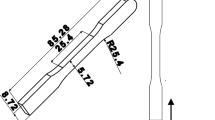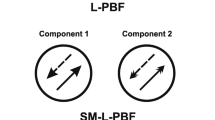Abstract
At the Johns Hopkins University Applied Physics Laboratory (APL), glass bead-filled polyamide (a.k.a. nylon) (GFN) is being used frequently for functional parts and systems, built using a laser-based powder bed fusion (PBF) additive manufacturing (AM) system. Since these parts have performance requirements, it is important to understand the mechanical properties of the additively-made GFN as a function of build orientation and build parameters. In addition, the performance of the AM system used to manufacture these parts must be evaluated in order to understand its capabilities, especially in order to determine the dimensional precision and repeatability of features built with this system. This paper summarizes recent APL efforts to characterize the GFN powder, the mechanical properties of parts made with GFN, and the performance of the laser PBF machine while running GFN using an AM test artifact.
















Similar content being viewed by others
References
ASTM International, Standard Terminology for Additive Manufacturing Technologies. Standard F2792-12 (W. Conshohocken: ASTM International, 2012).
D.L. Bourell, M.C. Leu, and D.W. Rosen (eds.), Roadmap for Additive Manufacturing—Identifying the Future of Freeform Processing. The University of Texas Austin, Austin, TX (2009).
Measurement Science Roadmap for Metal-Based Additive Manufacturing. http://events.energetics.com/NISTAdditiveMfgWorkshop/pdfs/NISTAdd_Mfg_Report_FINAL.pdf. Accessed May 2013.
EOS Material Data Sheet for PA 3200 GF, 2009, EOS GmbH, Krailling, Munchen.
J. Slotwinski, E.J. Garboczi, P.E. Stutzman, C.F. Ferraris, S.S. Watson, and M.A. Peltz, J. Res. Natl. Inst. Stand. Technol. (2014). doi:10.6028/jres.119.018.
ASTM International, Standard Test Method for Tensile Properties of Plastics. Standard D638-14 (W. Conshohocken: ASTM International, 2014).
ASTM International, Standard Terminology for Additive Manufacturing—Coordinate Systems and Test Methodologies, Standard F2921-11, ASTM International (PA: W. Conshohocken, 2011).
S. Moylan, J. Slotwinski, A. Cooke, K. Jurrens, and M.A. Donmez, J. Res. Natl. Inst. Stand. Technol. (2014). doi:10.6028/jres.119.017.
Acknowledgement
The authors acknowledge the helpful contributions of Cavin Mooers (APL), Zhiyong Xia (APL), Mark Matthews (GE Inspection Technologies), Whitney Yetter (GE Oil & Gas), Clarissa Ferraris (NIST), and Max Peltz (NIST).
Author information
Authors and Affiliations
Corresponding author
Rights and permissions
About this article
Cite this article
Slotwinski, J., LaBarre, E., Forrest, R. et al. Analysis of Glass-Filled Nylon in Laser Powder Bed Fusion Additive Manufacturing. JOM 68, 811–821 (2016). https://doi.org/10.1007/s11837-015-1792-y
Received:
Accepted:
Published:
Issue Date:
DOI: https://doi.org/10.1007/s11837-015-1792-y




